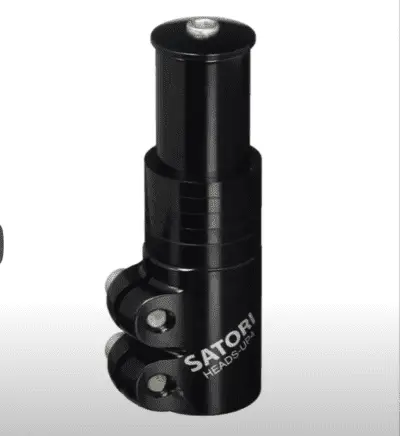
There are lots of ways and solutions for this problem, I believe I’ve tried everything there is to try regarding increasing handlebar height. I’ve found there are several things that work the best but each in a different way.
One of the solutions which work the best of all is getting a new handlebar. A handlebar that has a higher rise between the stem and bar ends will help tremendously. The problem with handlebars is, they are quite limited on how much elevation they can provide. For people looking to raise handlebars just a bit, this is a perfect solution. However, I’ve found that this isn’t enough for the majority of people with this problem.
Another solution would be getting a stem that is angled upwards so it raises your handlebar. This is a decent solution for height, but it has problems of its own. The problem is, you are used to your bike steering as it is. These stems have a shorter effective distance from the head tube which completely changes the bike’s steering capabilities. Makes it quicker if this length is shorter, and sluggish if it’s longer. Good examples of these would be Wake MTB Stem 45 Degree 31.8 90mm, GANOPPER 31.8 Stem 60mm 30 Degree Riser, or SanZhi Bike Stem 31.8 25.4 110mm 0-60 Degree Adjustable MTB Riser.
The third solution would be stem risers. But are stem risers safe?
How Stem Risers Work
A solution that pretty much worked for everyone who wanted to increase handlebar height is adding a stem riser. It’s a piece that prolongs the fork steerer so that the stem is fitted much higher than it usually is. The usual size is 5 inches or about 13 cm. There are different sizes but I would stick to this as a maximum for reasons which I will explain later on.
A stem riser has the same clamping bolts as a stem has which are used in the same way to clamp onto the fork steerer. This type of stem riser works only on threadless steerers, which is where this problem usually occurs because the threaded steerers allow you to increase the handlebar height at will.
Are Stem Risers Safe?
Absolutely yes! Unless you want to use them on a carbon steerer…
Carbon flexes too much for that increased length to be safe. There is an issue with how tight you can clamp a carbon steerer. In other words, a carbon steerer would have a high chance of breaking with a stem riser. The stem riser essentially creates a longer lever on the frame. With a longer lever every time you apply force on the handlebars that force is increased on the steerer and frame.
Aluminum or steel steerer, on the other hand, is perfectly safe to use stem riser on. Metal, even aluminum has more than enough strength to not break with increased length.
Another thing I would like to mention is that not every stem riser is equally safe. The thing is, now effectively you have a steerer put together from two pieces, a steerer itself and a stem riser. In order for it not to come off, the stem riser needs to be thick enough. And more importantly you need to be able to clamp it much harder than a normal stem.
Which Stem Riser To Buy
As I said before, it’s important to know which stem riser will do the job and if you can answer yes to the question of “are your stem risers safe?”. Lots of people came to me with lots of different stem risers. Most of them had a problem that they were not installed properly, and some of them were just not safe enough. The ones that were not safe enough were made from thin aluminum and the clamp would always get loose in time especially if you would push the bike a bit and not ride like an 80-year old.
Before I had them at my shop, I used to order them online for people who wanted to raise their handlebars. Most of the time I went with Satori Black Alloy Height Adapter. It’s not the lengthiest, but it’s the thickest and most durable. To put it straight, it’s right where you want it to be regarding the price, safety, length, weight, and everything else. An important thing to mention is that it never failed to clamp properly and hold tight during anything you throw your bike into.
A decent cheaper alternative would be Weanas Bike Stem Riser, although it’s not as tough as Satori’s one, and I have never seen it tested on any rough terrain.
How To Install Stem Riser Properly
The first thing to do is to take off the stem. I like to not use a bike repair stand in this situation, it’s easier if the ground keeps the fork at least somewhat in place. One of the things that you probably wouldn’t do before installing a stem riser is cleaning the steerer tube. Because of stem riser being an additional part of this steering system, it needs to hold firmly to the steerer tube. Usually, what happens is some grease comes there from the headset, especially if your steerer slides down when you are doing this on a bike repair stand. I usually use some rubbing alcohol or a degreaser to get rid of any grease.
Proceed with putting the stem riser onto the steerer but don’t tighten the sideways clamp bolts yet. Install the stem and tighten the upper cap with a long bolt that you get with the stem riser. It’s advisable to use the cap you get with the stem riser as well, as it is usually much thicker than a normal one. Usually, you can tighten the cap bolt to a 4 nM torque for it to work fine but I prefer doing it the old fashion way. This way requires a bit of playing with it, tightening slowly until there is no movement in the headset and then just a bit more to make it firm enough. If you reach the point that makes turning the wheel difficult it means you tightened it too much. Basically, you need to find the sweet spot in between.
After that is tightened properly, straighten the stem riser and the stem in a riding position. Since the stem riser is a separate part I like to turn it in a position so that the bolts are straight behind the steerer to make it aesthetically pleasing. First tighten the stem clamping bolts, just so it doesn’t move that easily as you will tighten them correctly at the end. Now you can tighten the stem properly. Stem clamping bolts are fine if tightened as it is written on the stem, most are 5-7 nM, although you should check your own. I do this first so that the bolts stay aligned for the already mentioned aesthetics. Now tighten the stem riser clamping bolts until you can’t turn it anymore. Most of the time there won’t be a specified torque because stem riser clamps are much thicker, but you should not worry because being thicker means you can tighten them much more. The aluminum steerer can withstand more than 30 nM and you won’t need nearly as much.
When you are done, check once more for headset movement, and that nothing turns in comparison to the wheel. If everything is good that means it’s safe to ride. Remember if you want your stem risers safe, you have to do it the right way.
- Maximum Height Extension: 70mm (2.7 inch). Include 4 gaskets, 3 x 10mm (2/5 inch) and 1 x 5mm (1/5 inch). Can freely adjust the gasket to fit your own height
- Easy installation, just connect up the original front fork stem
- Forged 6061 Aluminum Alloy Material with polished anodized finish, Solid, Secure, Durable.
- Suitable for Most bike with 1-1/8 threadless headset
- Handling more flexible, light weight, easier to force when climbing, operation is comforta
Prices pulled from the Amazon Product Advertising API on:
Product prices and availability are accurate as of the date/time indicated and are subject to change. Any price and availability information displayed on [relevant Amazon Site(s), as applicable] at the time of purchase will apply to the purchase of this product.
Are Stem Risers Safe and Recommended For Mountain Biking or Road Cycling?
To be honest, I hear this question a lot.
In my opinion, it depends on how you ride and what your goals are. It will cripple your performance if you want to achieve any serious results in road cycling, that much I’m certain of. However, if you are just a casual cycler, and maybe with a bad back, go for it. It will allow you to do something you love without experiencing discomfort.
Mountain biking, on the other hand, is a bit different. I wouldn’t recommend it at all for anything mountain biking-related. Sooner or later you will hit some jump, or go over some rocks, and that is a problem for stem risers. They will hold at first, maybe even endure a lot of mountain biking, but they are not really designed to withstand that type of riding. Also, controlling your bike is next to impossible on rough terrain if you are riding with your back straighten upwards, which stem risers provide for you.
In other words, casual riding on flat surfaces – Yes!
Serious or semi-serious cycling and mountain biking – No.

